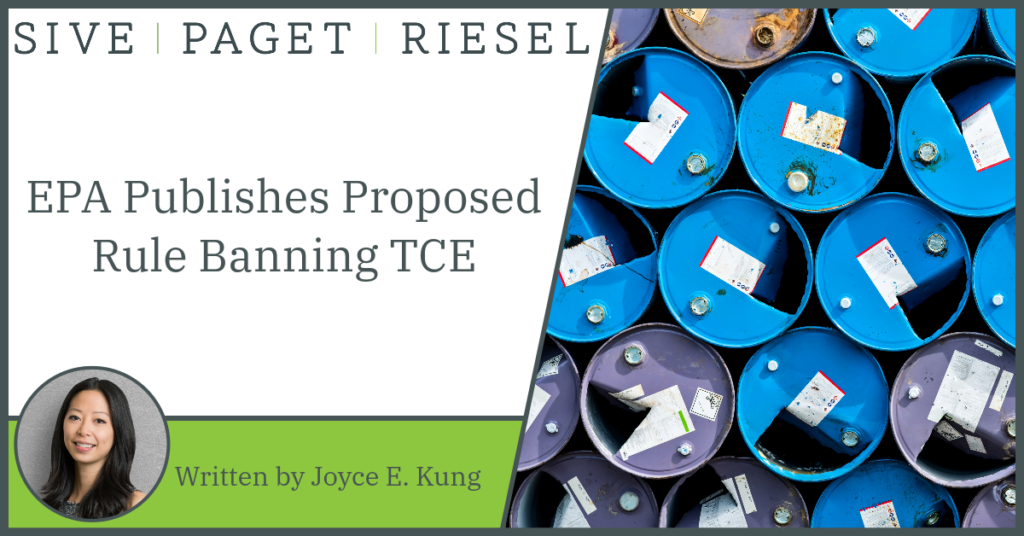Blog

EPA Publishes Proposed Rule Banning TCE
On October 31, 2023, the U.S. Environmental Protection Agency (EPA) published a proposed rule to ban all manufacturing and use of trichloroethylene (TCE) under Section 6(a) of the Toxic Substances Control Act (TSCA) (15 U.S.C. 2605(a)). TCE is a highly toxic and carcinogenic chemical that has historically been used in numerous industrial, commercial and consumer applications, including in cleaning and furniture care products, degreasers, brake cleaners, and tire repair sealants. TCE is also used in the manufacturing of certain refrigerants and in the production of battery separators used in electric vehicles and other transportation, security, and defense systems. TCE is a known carcinogen and can cause significant adverse health impacts by all routes of exposure, including through chronic inhalation and dermal exposure. Known health risks include non-cancer effects (liver toxicity, kidney toxicity, neurotoxicity, immunotoxicity, reproductive toxicity, and developmental toxicity) as well as cancer (liver, kidney, and non-Hodgkin lymphoma).
The proposed rule is a response to a risk evaluation conducted by EPA in November 2020 and a revised determination issued in January 2023 that TCE presents an unreasonable risk of injury to health. Under TSCA, EPA must eliminate unreasonable risk of injury to health or the environment. Thus, the proposed rule intends to protect human health by banning the manufacture, processing, and distribution of TCE for all uses.
EPA’s proposed rule would amend 40 CFR part 751 to prohibit most uses of TCE within one year for consumer products and most commercial uses where safer alternatives are already available. This would entail, among other things, prohibitions on the manufacture and importation of TCE within three months of the final rule publication; processing and distribution in commerce of TCE within six months of the final rule publication; industrial and commercial use of TCE within nine months of final rule publication; manufacturing TCE for batch vapor degreasing in certain degreasing equipment within six months after final rule publication; and processing TCE for industrial and commercial use for such batch vapor degreasing within nine months after final rule publication. Some of the uses that will require longer phase-out periods include applications in rocket booster nozzle productions (10 years), in battery separators used in electric vehicles (10 years), in certain Department of Defense naval vessels and systems (10 years), and in the manufacture of the refrigerant known as 1,1,1,2-Tetrafluroethane (also known as hydrofluorocarbon134a or HFC–134a) (8.5 years). Further, to support cleanup of past TCE contamination, the proposed rule allows for essential lab use and proper disposal of TCE wastewater to continue for 50 years.
The proposed rule would also implement stronger worker protections and workplace controls, including workplace chemical protection programs (WCPP) setting exposure limits, particularly for those commercial and industrial uses that would be phased out over a longer period of time. EPA has proposed an eight-hour existing chemical exposure limit (ECEL) value of 0.0011 ppm (1.1 ppb; 0.0059 mg/m3), within nine months of the final rule publication, and certain monitoring required within six months of the final rule publication. Other worker protections include required control procedures and plans, exposure control plans, information and training, and availability of personal protective equipment. Other notification and recordkeeping requirements are also proposed.
Currently, Section 16 of TSCA provides for civil and criminal penalties for violations of TSCA or TSCA rules, including civil penalties of up to $46,989 per violation per day for each day such violation continues, and criminal penalties that may impose additional fines and imprisonment.
EPA is accepting public comments on the proposed rule (including whether the agency should consider a de minimis level of TCE to account for impurities) until December 15, 2023 via docket EPA-HQ-OPPT-2020-0642 at www.regulations.gov.